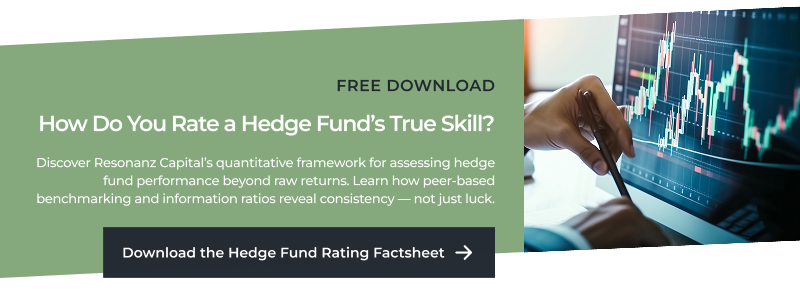
Understanding Hedge Fund Quantitative Metrics: A Handy Cheatsheet For Investors
Discover key quantitative metrics for evaluating hedge funds, including performance, risk, and risk-adjusted return metrics. Learn about volatility, maximum drawdown, beta, Sharpe ratio, Sortino ratio, and additional measures like alpha and correlation for comprehensive fund analysis.
8 min read | Jun 25, 2024
Hedge funds provide distinct return opportunities that differ from traditional investments in stocks and bonds. Due to their low correlation with other asset classes and the use of hedging strategies, hedge funds are designed to deliver positive returns irrespective of market trends. But what implications does this have for hedge fund performance?
When evaluating hedge funds, investors rely on a range of quantitative metrics to assess performance, risk, and overall suitability for their investment goals. These metrics provide a systematic and objective framework to compare funds, understand their behavior under different market conditions, and make informed investment decisions. In this blog post, we will delve into some of the key quantitative metrics that are most common for assessing hedge fund performance, ensuring that you have a comprehensive understanding of how to evaluate these complex investment vehicles.

Performance Metrics
Cumulative Performance
Cumulative performance represents the total percentage change in a fund's net asset value (NAV) over a specified period. This metric is commonly evaluated over trailing periods such as the past three months, one year, three years, or five years. Additionally, cumulative performance is often assessed for individual years, the current calendar year (YTD), and the entire period since the fund's inception.
Cumulative performance provides a snapshot of the fund's growth trajectory over these periods. For example, a three-year cumulative performance of 15% indicates that the fund’s NAV has increased by 15% over the past three years.
Annualized Performance
Annualized performance converts the cumulative return into an annual average return, offering a normalized view of performance over different time periods. This metric is essential for comparing funds with different inception dates or performance periods.
For instance, if a fund has a three-year annualized performance of 7%, it means the fund has, on average, grown by 7% per year over the last three years.
Risk Metrics
Volatility
Volatility measures the degree of variation in the fund’s returns over a specific period, typically expressed as a standard deviation. It indicates the level of risk associated with the fund’s returns. A higher volatility means greater risk, as the fund’s returns are more spread out over time.
For example, a one-year volatility of 10% suggests that the fund’s monthly returns fluctuate, on average, by 10% from the mean return.
Skewness
Skewness measures the asymmetry of the return distribution of the fund. A positively skewed distribution indicates that the fund has more frequent returns that are less than the mean/median returns and occasional large gains, while a negatively skewed distribution suggests more frequent returns that are greater than the mean/median returns and occasional large losses.
Understanding skewness is crucial for investors because it provides insight into the likelihood of extreme returns, either positive or negative. For example, a fund with a skewness of 0.5 has a return distribution with a slight tilt towards higher returns, indicating a potential for larger upside gains compared to downside risks.
Kurtosis
Kurtosis measures the "tailedness" of the return distribution, indicating the presence of extreme values in the returns. High kurtosis means that the fund’s returns have more extreme outliers, which can imply higher risk. Low kurtosis suggests a more stable return distribution with fewer outliers.
For instance, a kurtosis value significantly higher than 3 indicates a leptokurtic distribution, which means the fund has a higher probability of extreme returns (both gains and losses) compared to a normal distribution. Understanding kurtosis helps investors assess the potential for unexpected, significant deviations from the average return.
Maximum Drawdown
Maximum drawdown quantifies the largest peak-to-trough decline in the fund’s NAV over a specific period. It helps investors understand the potential downside risk and the extent of losses they might endure.
For instance, a maximum drawdown of 12% over three years indicates that the fund’s NAV fell by as much as 12% from its highest point during that period.
Risk-Adjusted Return Metrics
Sharpe Ratio
The Sharpe ratio is one of the most popular measures of risk-adjusted returns used by hedge funds. It evaluates the fund’s return relative to its risk, using the risk-free rate (such as the USD 3-month LIBOR) as a baseline. It is calculated by subtracting the risk-free rate from the fund’s return and dividing by the fund’s volatility.
A higher Sharpe ratio indicates better risk-adjusted performance. For example, a Sharpe ratio of 1.5 suggests the fund provides 1.5 units of return for every unit of risk. Note that Sharpe ratios may be more attractive during periods of low-interest rates and less attractive during periods of higher interest rates.
Information Ratio
The information ratio measures the fund’s returns relative to a benchmark, adjusted for risk. It is calculated by dividing the fund’s excess return over the benchmark by the tracking error (the standard deviation of the excess return).
A higher information ratio indicates better performance relative to the benchmark. For instance, an information ratio of 0.8 means the fund’s excess return is 0.8 times the tracking error.
Sortino Ratio
The Sortino ratio measures a fund’s returns relative to its downside risk, distinguishing it from the Sharpe ratio, which considers both upside and downside volatility. The Sortino ratio is particularly useful as it focuses solely on downside risk, assuming investors are comfortable with volatility when it leads to gains. This provides a clearer picture of how well the fund compensates investors for taking on downside risk, aligning more closely with the investor’s risk-averse nature.
The ratio is calculated by dividing the fund’s excess return (annualized return minus a predetermined minimum acceptable return) by its downside deviation below the minimum acceptable return.
Benchmark-Related Risk and Performance Metrics
To gain a comprehensive understanding of a hedge fund’s performance and risk profile, it is important to consider additional metrics beyond the standard performance and risk-adjusted return metrics. In doing so, it is necessary to have a point of comparison against which to evaluate returns. These comparison points are known as benchmarks.
Beta, correlation, and alpha are critical measures that offer deeper insights into how a fund behaves in relation to the broader market, how it contributes to portfolio diversification, and the value added by active management.
Beta
Beta measures the fund’s sensitivity to market movements, specifically its correlation with a benchmark index, such as the MSCI World Index. Beta can also can be measured relative to any benchmark index, including equity, fixed-income or hedge fund indexes, to reveal a fund's sensitivity to movements in the particular index. A beta of 1 indicates that the fund’s returns move in line with the market, while a beta greater than 1 indicates higher sensitivity to market movements. For example, a beta of 1.2 over three years means the fund is 20% more volatile than the benchmark.
Beta is a good measure of determining how much equity exposure — to a particular asset class—a fund has and allows an investor to determine if and/or how large allocation to a fund is warranted.
Correlation
Correlation measures the degree to which the fund’s returns move in relation to another asset or index. A correlation of 1 indicates perfect positive correlation, meaning the fund’s returns move exactly in tandem with the benchmark. A correlation of -1 indicates perfect negative correlation, where the fund’s returns move in the opposite direction of the benchmark.
Understanding correlation helps investors determine how well a hedge fund might diversify their portfolio. The lower the correlation hedge funds have to each other, the more likely the portfolio composed of those funds is well diversified. Similarly, a low or negative correlation of a hedge fund allocation (as an asset class) with traditional asset classes like stocks and bonds can enhance overall portfolio diversification.
Alpha
Alpha is not simply the difference between the fund return and the benchmark return, but alpha takes into account the amount of risk taken as well.
In other words, alpha represents the fund’s ability to generate returns above a benchmark index, adjusted for risk. It is an indicator of the fund manager’s skill in generating excess returns. A positive alpha suggests that the fund has outperformed the benchmark after accounting for market risk, while a negative alpha indicates underperformance.
For example, an alpha of 2% means the fund has outperformed the benchmark by 2% after adjusting for its risk profile. Alpha is crucial for assessing the value added by active management.

Conclusion
There are numerous other quantitative techniques that help analyze performances of hedge funds, but we aimed to cover the main ones that every hedge fund investor should know.
However, when evaluating hedge funds, it is essential to adopt a holistic approach, combining quantitative metrics with qualitative analysis. While quantitative metrics provide a clear and objective framework for assessment, qualitative factors such as fund management quality, investment and risk management philosophy and processes, as well as operational infrastructure are equally important.
By integrating both aspects, investors can make well-rounded and informed investment decisions, enhancing their potential for achieving desired returns while managing risk effectively.
Resonanz insights in your inbox...
Get the research behind strategies most professional allocators trust, but almost no-one explains.